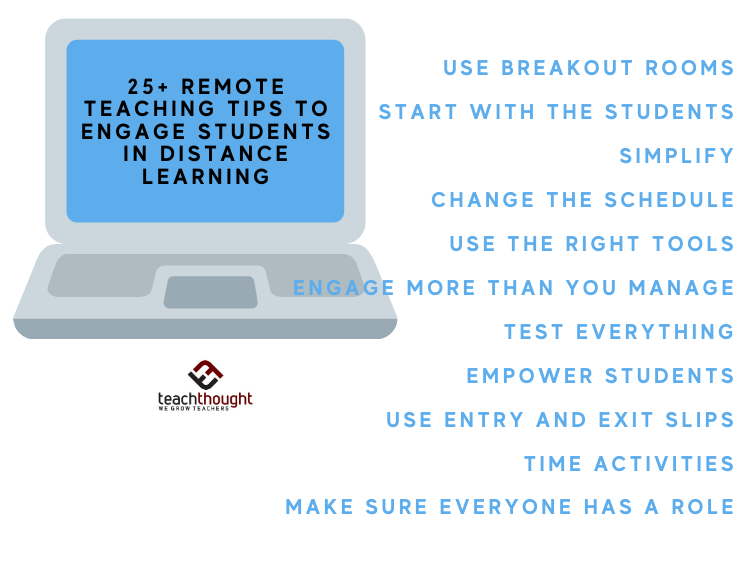
What Are The Best Tips To Engage Students In Distance Learning?
by Terry Heick
As remote teaching and learning become more common–if not the standard in many places over the next six months–I thought it might be useful to offer some remote teaching tips to engage students in distance learning.
As with all content, how useful and relevant any of these are depends on your context–experience, grade level, need, priorities, and strengths as a teacher, etc. Some are possibly too general to help (e.g., ‘Simplify’), but hopefully out of the 25 remote teaching tips below, one or two might stick and make your planning a little easier–and more engaging for students.
25 Remote Teaching Tips To Engage Students In Distance Learning
1. Start with students
Consider their lives. Their day. Their well-being. I wrote some about this recently:
“You can also argue that this isn’t your job–and it’s certainly true that considering the well-being of every student your responsibility is a fast-track way to see some of the warning signs of teacher burnout. You may also know that the majority of your students are fine and the ones who may not be are almost impossible to help and that makes it hard sometimes. But when the opportunity presents itself, check in with your students–really check in with them. If you must assess something, assess their well-being. Track that data. Address those needs. Be the teacher you would’ve needed during a pandemic when you were a child.”
The idea here is to not get distracted that you’re at home and so are they and that everything is ‘different.’ Start instead with the student and their reality and needs and the new and urgent opportunities in front of them.
2. Simplify
Simplify what you teach and how you teach it and how students will show what they’ve learned. Prioritizing skills and concepts from your curriculum is more necessary now than ever.
3. Work backward from the context of remote teaching
Synchronous, ‘live’ teaching online to a group of children is very different than doing the same in-person–and neither is easy.
When you plan backward from the context and characteristics of remote teaching and learning–where distractions are uncontrollable, bandwidth matters, and students are not with their friends but rather their family–the lesson or activity has a better chance to work. Think small, bite-sized learning activities with clear objectives and intentional transitions–all while planning for and necessitating student engagement and autonomy.
Actually, that’s not as different from ‘good teaching’ in-person as it seems.
4. Meet for briefer periods more frequently
This may not be possible. If you can only meet once a week and that’s it, then once a week it is. But whenever possible, ‘chunk’ learning–three times a week for 20 minutes or twice for 30 versus once for an hour. How effective this is depends on what you teach and the age of the students you’re teaching it to.
5. Be the ‘lead learner’ as much as you are the ‘teacher’
Put another way, model ‘caring’ about learning and the role it plays in well-being and growth. Show them what it means to be curious and active in this new learning environment.
6. Use lighting and sound to your advantage
Quality audio, strong lighting, Zoom backgrounds, catchy music for transitions between activities–whatever you need to do to get and keep their attention, use the technology tools at your disposal to make that happen.
7. Use games and music
I almost titled this one ‘take breaks’ but depending on your schedule, a ‘break’ may be less useful than simply transitioning or team-building, etc. That said, keep resources like Kahoot, coolmath.com, or even videos of others playing games to engage students in distance learning during portions of the lesson or activity where it may be waning. (Think halfway points.)
The internet is full of games and music. Use them intentionally. Here are some video games to teach with and classic hip-hop music you can teach with to get started.
8. Use different tools for different things–usually
While many video streaming platforms and learning management systems have a robust set of tools to consider, start with what you know that also works from students and then work from there. Private messaging with Zoom and document collaboration with Google Drive while grading with an app–while students use digital portfolios on a separate platform–that’s your reality for remote teaching in 2021.
That said, there’s something to be said for simplicity. If it makes your life easier and students still have access to the same learning opportunities, using one tool for functions it may not necessarily be designed for may serve everyone better in the end.
9. Thinking differently about ‘classroom management‘
This needs more explanation, I know. But you can’t ‘manage’ students the same way online as you can in person. Behavior is different and addressing that behavior–what you reinforce and what you reward and what you ignore–will also be different. Further, you have to be extra careful about how you address those behaviors because it’s very literally in front of the entire classroom–in many cases with many
10. Try to ensure the privacy of each student
Another ‘easier said than done’ remote teaching tip. But privacy laws alone make remote learning a maze of policies, laws, and potential pitfalls. Who sees what–what you see in their homes and they see in one anothers’–it’s a lot to sort.
11. Design for participation
This isn’t always doable, but when possible, design lessons–or activities within lessons–that don’t just encourage ‘engagement’ and student participation, but that won’t work without engagement and participation.
See also Remote Learning Tips For Parents
12. Test everything, plan ahead, and assume everything will break
Do your best to assume someone’s connection (maybe yours) is going to go out at some point. Assume the link you share will be broken and that the private message you send will be seen by everyone–and so on. That’s okay. If you have a plan ahead of time, you can mitigate the ‘loss’ of time and learning.
13. Empower students: emphasize autonomy and engagement
The easiest strategies here are student voice and choice in what and how they learn and demonstrate learning. This applies to lessons you’ve created for students to do either together or apart.
Asynchronous, self-directed, ‘genius’ learning–that is, learning students do on their own because they want to–is another way to empower students as a remote teaching tip. For pre-school students, I’ve been using Marco Polo Learning lately and paired with Epic books, makes a powerful combination for students to be empowered in their own learning.
See also Virtual Teaching Tips For Beginners
14. Think Before, During, And After Learning
And in pursuit of empowering students, encourage students to ‘own’ their learning and self-direct it. A strategy here is BDA: Before, During, And After. This will help you think carefully about what you want students to do–and be able to do–before online sessions, during online sessions, and after online sessions.
15. Use the right platform for the right teaching
This one’s simple but don’t use Google Drive to share video and don’t use Zoom to carry out ongoing conversations with students and don’t use YouTube to host all student portfolios, etc. Use the right tool for the right purpose.
16. Know the features and functions of that platform inside and out
And when you do find a tool that actually makes your life easier while (more crucially) improving student learning, learn how to use it effectively. You don’t necessarily have to use every nook and cranny of Skype or FlipGrid to get the most out of it. The point is to know the platform and then selectively use the bits and pieces that work for you and your student.
17. Personalize learning objectives or approaches
Personalized learning is always a good idea, but in remote teaching, it may be even more critical than a standard classroom (if for no other reason than it’s easier to ‘lose’ students or for students to ‘hide’ during synchronous distance learning). A basic strategy here is to create tiered learning targets.
For example:
Tier 1: Students will be able to roughly define a metaphor
Tier 2: Students will be able to define and identify two obvious metaphors in an excerpt
Tier 3: Students will define and identify a ‘less obvious’ metaphor
Tier 4: Students will define, identify, and analyze the effect of an obvious metaphor
18. Connect individually through messaging or individual ‘rooms’
This helps build relationships with students while also improving the credibility of online learning–helping them to see that they’re not simply fulfilling their academic duty but rather connecting with people who care around content designed to (hopefully) make their life better.
19. Be selective in what you do together
Generally speaking, the definition of synchronous learning is learning the same thing at the same time. Broadly speaking, limit lecturing during remote teaching (this is a common synchronous teaching strategy) and use alternatives to lecture instead.
20. Create breakout rooms ahead of time
Among other benefits, creating breakout rooms before class even begins forces you to have reasons for those breakout rooms–that is, provides a kind of framework for grouping, station teaching, collaboration, small-group instruction, and more.
You can read more about them in What Are Breakout Rooms? A Definition For Teachers.
21. Leverage the beginning and end of each remote teaching session
Consider ice-breakers at the beginning–or entry slips–and fun team-building or exit slips at the end.
22. Use quick, informal, checks for understanding
Here are some easy ways to check for understanding. The idea is to consistently perform simple, disarming checks for understanding–ideally around the lesson objectives or related ideas.
23. Be intentional with transitions
Transitions between activities are crucial to maintaining momentum and student engagement. They are also necessary to reduce wasted time.
24. Use a timer
See above. You might be surprised. And don’t make this complicated–use an app on your phone to time individual activities or the running time on Zoom, Skype, Google Hangouts, etc.
25. Consider digital grouping strategies
I’ll write more about this soon. To get you started, consider the grouping strategies you’ve used successfully in your classroom and re-imagine them–and experiment with them–to see how they translate to remote teaching and learning.
Bonus: Teach for engagement, not coverage
Another remote teaching tip: Consider the aforementioned checks for understanding, cold calling, accountable talk, quick team-building games, digital polls, backchannel discussions, and more.
In a time of relative social instability and unique social-emotional needs–not to mention reduced standardized testing–the justification for ‘coverage teaching’ is weaker now than ever. Of course, that doesn’t mean ‘don’t cover content,’ but rather emphasize student well-being, engagement, and autonomy as you work with them in remote teaching and learning.
25 Remote Teaching Tips To Engage Students In Distance Learning
